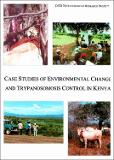Case studies of environmental change and trypanosomosis control in Kenya.

(en=English; ar=Arabic; fr=French; pt=Portuguese)
Authors
African Union Inter-African Bureau for Animal Resources
AU-IBAR
Item Usage Stats
120
views
views
37
downloads
downloads
Abstract
The human population of east Africa is very unevenly distributed across the region and, as can be seen in Figure 1, is concentrated around Lake Victoria, in the highlands, and along the coast. The conjectural limits of tsetse (Glossina spp.) in 1973 (Ford and Katondo, 1977) are also indicated. Disregarding the more arid areas of north-eastern Kenya and northern Tanzania, where tsetse are generally unable to survive because it is too dry, there is a reasonably good match between tsetse distribution and areas of low human population density. Looking more closely at Kenya, it is clear that tsetse are on the eco-climatic limits of their distribution (Map 1), both in terms of increasing aridity to the north-east, and lower temperatures with increasing altitude. Available records indicate that viable tsetse populations are unlikely to be able to survive at heights more than 1,750-2,000m above sea level Over the past fifty years, the number of people in Kenya, Uganda and Tanzania has quadrupled, and, despite the ravages of HIV/AIDS, is forecast to double again in the next 30-40 years (Figure 2). A striking contrast between the three countries is evident in this figure, with Uganda having twice the mean population density as Kenya, and thrice that of Tanzania. In 1996, mean densities were 100, 50 and 30 people per square kilometre, respectively.